What tools are available inside the Landing Page editor?
Once you start creating your landing page, you can customize your page to better suit your needs. Here are a few things that you will be able to add and customize inside the GetResponse Landing Page
- Section
- Text
- Image
- Button
- Video
- Divider
- Spacer
- Social media icons
- Custom code
- Gallery
- Timer
- Form
- Popup
- Webinar signup form
- Product box
- Course box and table of contents
Sections
Sections are a great way of organizing the content of your page. You can think of a section as a container that groups elements. When you group elements such as buttons, labels, or images, you can move or delete them with a single click.
Sections have two main functions:
- They organize elements into logical groups.
- They allow you to manage your content in an easy way.
Most of our landing page templates are composed of sections. You can also add extra sections to your template.
Learn more about how to use sections in our landing page editor.
Text
You can either add a new text box from the toolbar or edit the text that’s already in the template. Click the text or text box to make changes. The editing options include:
- Type
- Font
- Font size
- Font style
- Font color
- Background color
- Alignment
- Line height
- List style
- Hyperlink
- Emojis
- Block settings (color, padding, border, radius, shadow, and background media)
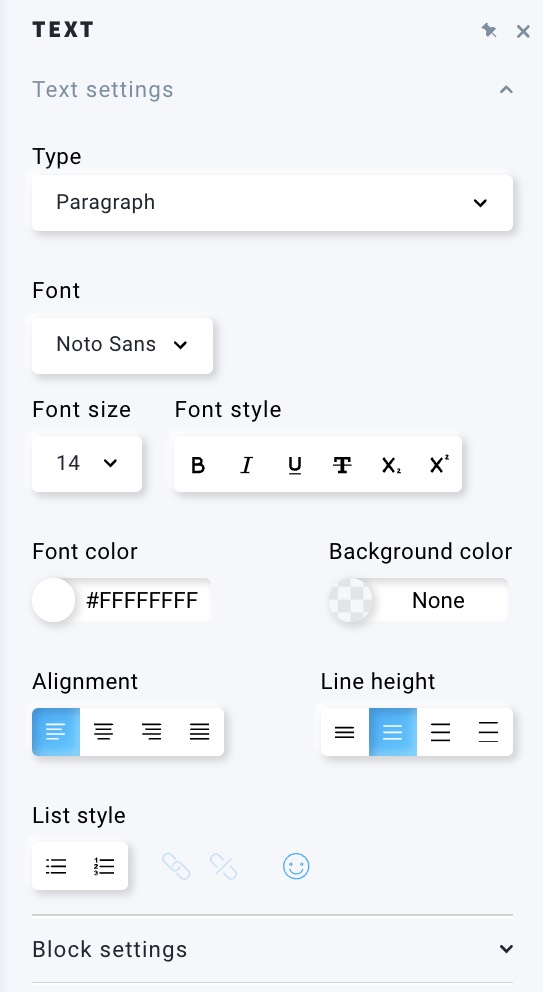
Image
In GetResponse, you’ll find a variety of stock images to choose from, or you can upload your own graphics (images or gifs) from your computer or from a URL. Once they are inserted, click on them to see more editing options. Those include:
- Alt text
- Clickthrough link
- Width and height
- Scale to full-screen width on mobile toggle
- Opacity
- Alignment
- Advanced settings (border, radius, shadow)
- Block settings (color, padding, border, radius, and shadow)
You can also replace or edit the image using a built-in photo editor right from the Landing Page editor.
To replace the image, click on the Replace button and select a different one. To edit the image in the editor, click on the Edit button.
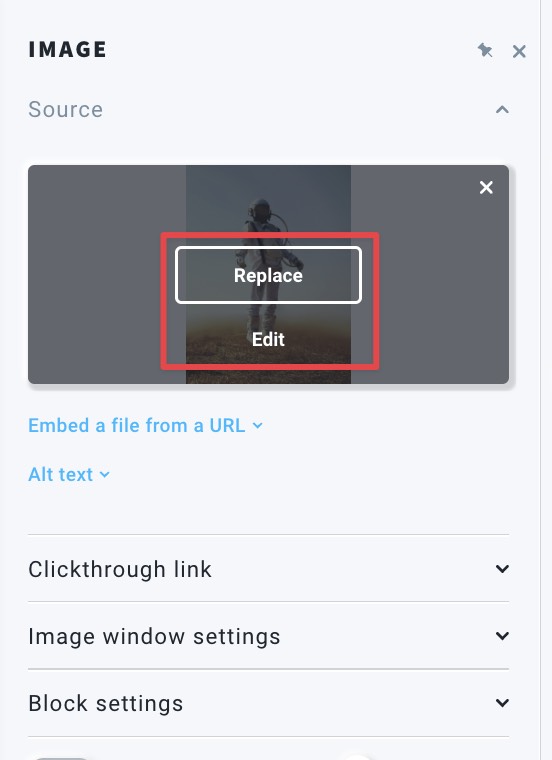
In the editor, you can crop, resize, adjust, and transform the image. You can also add filters, overlays, stickers, and text.
Once you finish editing, click on the Save link
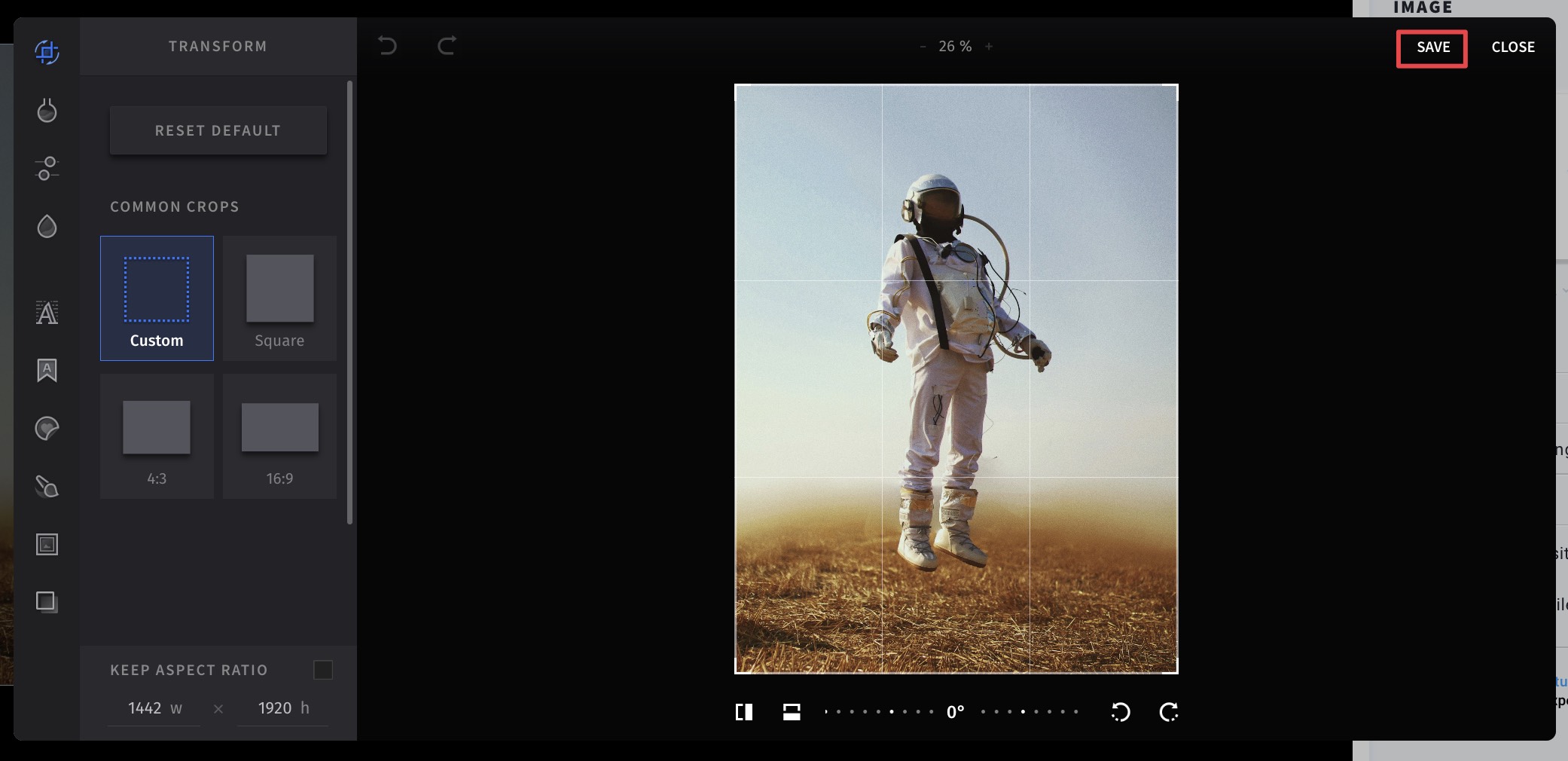
Button
If you want to link to a different website, phone number, PDF document, etc., you can use a button. Click on a button to adjust the following:
- Button text
- Link type
- URL
- How should the link open?
- Style
- Shape
- Size
- Alignment
- Advanced settings (radius, shadow)
- Block settings (color, padding, border, radius, and shadow)
Video
You can embed videos from video hosting platforms such as YouTube directly on your landing page. Once you drag the video block
- Muted autoplay – Automatically start playing your muted clip once the page is loaded (not every browser supports the autoplay)
- Mute – Enable mute as a default setting
- Loop – Set the video to play on repeated loop
- Controls – Show or hide default video controls provided by video platform
- Width and height
- Scale to full-screen width on mobile toggle
- Alignment
- Advanced settings (border, radius, shadow)
- Block settings (color, padding, border, radius, and shadow)
Learn more about how to add videos to your landing pages.
Divider
Dividers are graphic lines that can add little design accents to your page and help highlight the most important areas. You can adjust:
- Layout (horizontal or vertical)
- Style
- Height
- Alignment
- Block settings (color, padding, border, radius, and shadow)
Spacer
Use spacers to add additional space between the objects on your landing page. It can help you direct the focus of the visitors to important areas and give you more options for page design. You can configure the following settings:
- Color
- Border
- Radius
- Shadow
Social media icons
You can add social media
- Action – what should happen when one of the social media icons is clicked
- Social media platforms
- Style
- Layout (horizontal or vertical)
- Alignment
- Color
- Size
- Spacing
- Block settings (color, padding, border, radius, and shadow)
Learn more about how to add social media icons to your landing page.
Custom code
You can add your own HTML code, CSS formatting, and JavaScript to your landing page using the Custom code element.
Here you can find detailed information regarding the custom code block.
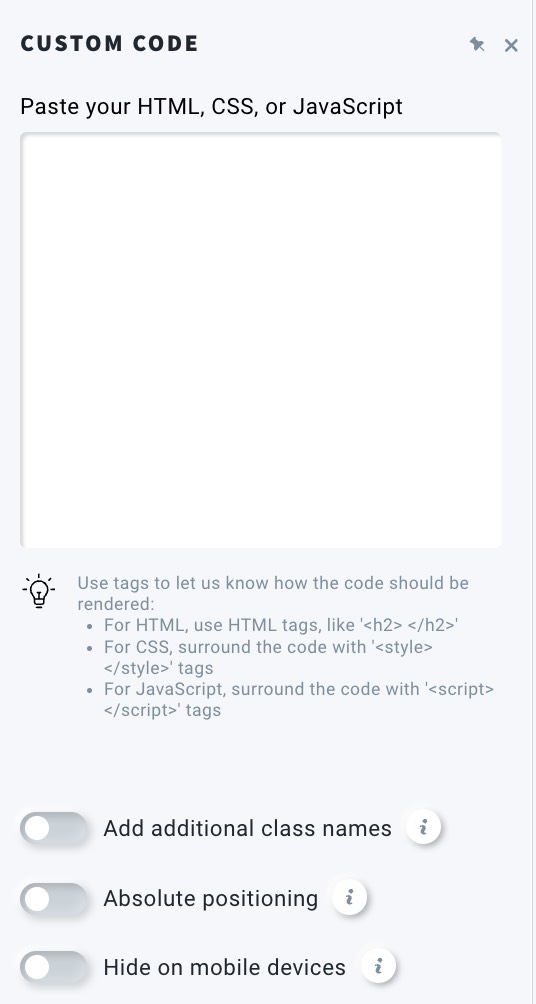
Gallery
You can add an image gallery to your landing page to present your products and services, draw visitors’ attention to highlights of your content, or create a visual vibe that will showcase your business. For this block, you can adjust:
- Images shown in the gallery
- Display style (masonry, grid, or slideshow)
- Width and height (for the slideshow display style)
- Image size (for the grid and masonry display styles)
- Horizontal and vertical image spacing (for the grid and masonry display styles)
- Advanced settings (border, radius, and shadow)
- Block settings (color, padding, border, radius, and shadow)
Timer
You can add a timer to your landing page to count down to a specific future date. You can also set up an evergreen countdown. It will count down from the moment your visitors open the page and trigger an upsell redirection. This is a great way to advertise a sale, upsell, or build anticipation for an event. It helps create a sense of urgency to encourage potential contacts to sign up to your list.
For this element, you can configure:
- Type (evergreen or fixed date)
- Countdown duration
- Format
- Counter design (font, font size, font style, font color, background color, padding, border, radius)
- Label design (font, font size, font style, font color and show labels toggle)
- Block settings (color, padding, border, radius, and shadow)
Learn more about how to use timers in our landing page editor.
Form
In our landing page editor, you can embed two types of forms:
- Signup forms – they allow you to convert visitors into subscribers and grow your business’s online reach.
- Contact forms – they allow your visitors to leave you messages and ask questions. You’ll be able to respond via chat or manually via email or phone.
Here you can find more information regarding the difference between contact and signup forms.
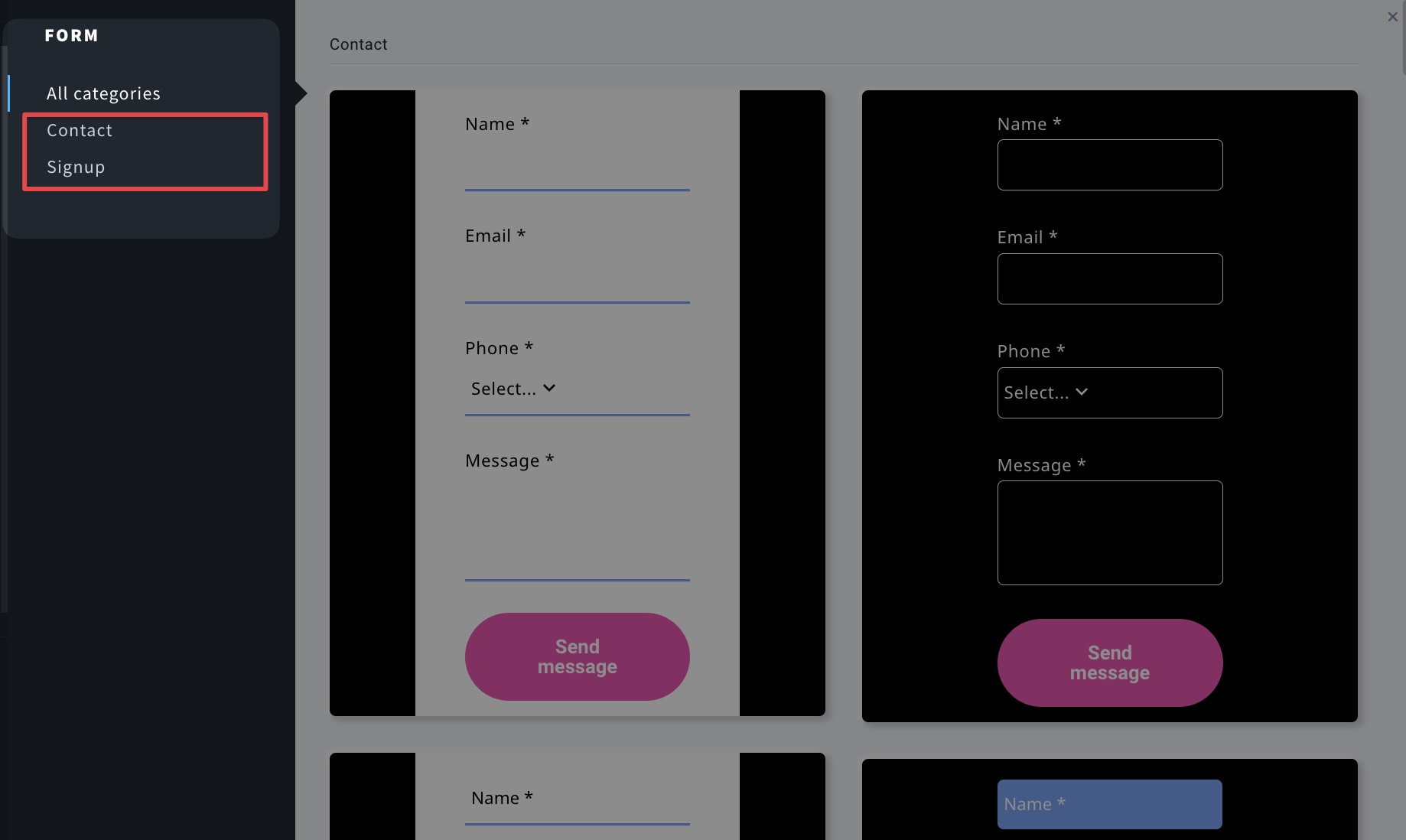
Popup
Adding popups to your landing page can motivate customers to take specific actions. Popups can include subscription forms or be used to promote sales and events. For popups, you can configure their:
- Size
- Position
- Trigger
- Timing
- Frequency
- Block settings (color, padding, border, radius, shadow, overlay, and overlay color)
Click here to learn more about popups in the landing page editor.
Webinar signup form
It”s also possible to add webinar
When you drag the module to your website, the webinar module includes the title, date, time zone, fields to enter the name and email address, and a join button. In the toolbar, you can configure the display of the following elements:
- Webinar title
- Date and time
- Form settings
- Block settings (color, padding, border, radius, and shadow)
Here you can find more information regarding webinar signup forms.
Product box
You can now add product boxes to your landing page to provide quick access and encourage more engagement from your visitors.
In order to use this feature, you need to connect your store to GetResponse or create a new store in our system.
After doing so, you will be able to select specific products to display, as well as modify the product box settings, including:
- Display settings
- Product card design
- Block settings (color, padding, border, radius, and shadow)
Learn more about adding a product box to your landing page.
Course box and Table of contents
You can now promote courses on your landing pages using our Course box and Table of contents blocks.
- A Course box is a block that allows you to display courses on your websites and landing pages in order to engage potential students. It offers your contacts the option to get familiar with your course and sign up with minimum effort.
- A Table of contents can be used to display the chapters and lessons included in the course on a landing page or website. Making use of it can be beneficial if you want to familiarise potential leads with the offer of your course.
Additional information regarding those course blocks can be found here.
Steps for legacy landing pages
Once you go into the Landing Pages Editor workspace, you can customize your page to better suit your needs. Here are a few things that you will be able to add and customize inside the GetResponse Landing Pages Editor:
- background
- section
- text
- image
- button
- form
- shape
- webinar
- video
- social sharing icons
- PayPal button
- custom code
Background
To change the background of a template, double-click it to view editing options. You can choose between:
- solid color
- gradient
- a different image. If you select an image, you can then decide how you’d like it to fit inside the section.

Border and shadow
For each of the elements that you add or edit, you can set a border and/or shadow. It’s a good way to make an item stand out when you need to bring attention to it. To access these settings, double-click on an element and choose the styling tools icon from the toolbar.

For the border, you can set:
- style
- size
- color
- radius
For the shadow, you can set:
- color
- direction
- distance
- spread
- blur

Sections
Sections have two main functions:
- They organize elements into logical groups.
- They allow you to manage your content in an easy way.
Most of our landing page templates are composed of sections. You can also add extra sections to your template.
Learn more about how to use sections in our landing page editor.
Text
You can either add a new text box from the toolbar, or edit the text that’s already in the template. Double-click the text or text box to make changes. The editing options include:
- font
- font size
- font color
- text background
- spacing
- bold
- italics
- underscore
- strikethrough
- orientation (left, center, right)
- bullet points
- numbered list
- hyperlink
- shadow

Image
In GetResponse you’ll find a variety of stock images to choose from, or you can upload your own graphics (images or gifs) from your computer or from a URL. Once you add them, double-click them to see more editing options. Those include:
- sizing
- border
- shadow
- hyperlink
You can also use one of the more advanced editing features, such as:
- filter
- pin
- orientation
- resizing
- cropping
- adding text
- drawing
- adjustment
Button
If you want to link to a different website, video, PDF document etc., you can use a button. Double-click on a button to adjust the following:
- sizing
- button text font
- font size
- font color
- bold
- italics
- underscore
- strikethrough
- hyperlink
- shadow
- button color
- border and shadow
Hyperlink
Elements such as text blocks, images blocks, and buttons include the option to add a hyperlink. To access this, double click the element and choose the hyperlink icon. Once chosen, you can select from different link types. These are:
- web address is used to redirect visitors to another online page of your choice.
- email will open up a new email window within the visitor’s default mail application directed towards the email of your choice. You are also able to place in a subject line for that email.
- section can be used to direct visitors to a specific section on your landing page.
- phone will allow visitors to make a phone call directly from the landing page to the number you select.
- webinar is used to connect an element to active webinars from your account. Selecting this type of link will take visitors to the registration page for the webinar you select.
Form
Some templates already come with a sign-up form. If they don’t, you can add one from the toolbar. Choose between a static form or a popup.

To edit the static signup form, double-click the form to enable the additional editing options:
- click the form or specific fields, or the button, to change the text and formatting
- double click the form to start adding additional fields: custom fields and Consent fields. Custom fields help you collect contact information. Consent fields allow your contacts to give their consent to your marketing or data processing policies when they sign up.
To add the fields, click the Webform fields button.
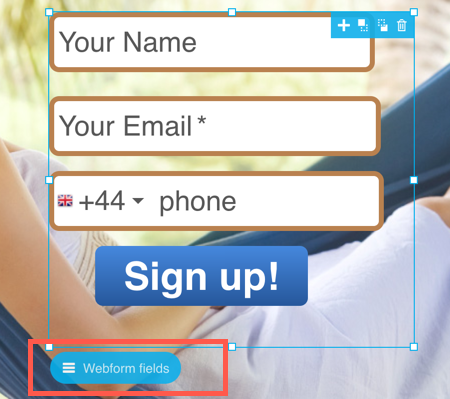
Then, click the Custom fields tab and select the custom fields you want to use. Click the Consent fields tab to view the Consent fields you’ve created in your account. Then, select the fields you want to add to the form.
Your form button can only collect contacts to your account. It can’t be used as a hyperlink. To direct contacts to a specific location after they sign up, use the thank-you page settings.
Shape
Shapes can help you add visual separation markers, draw attention to certain sections of your page or create frames for specific items. You can choose one of the following:
- circle
- rectangle
- horizontal or vertical line
Double-click the shape to edit its background, border, and shadow.
Webinar
To make it easier for your contacts to register to a webinar, you can add a webinar registration form directly to your landing page. Double-click on the webinar to select which one you want to use (if you have more than one scheduled). As with the form, you can then customize the registration form and add custom and consent fields.
Learn more about adding webinars to your landing page.
Video
You can embed videos from video hosting platforms such as YouTube directly on your landing page. Once you drag the video block onto the page, double-click it to set:
- the video URL
- border and shadow
- video display settings
Learn more about how to add videos to your landing pages.
Social sharing icons
These icons make it possible for your visitors to share the page on their feeds and drive more traffic for it. They aren’t editable.
The social sharing icons can’t be used as links to your social media profiles. If you want to link to your profiles, add the social media platform logos as images and use those as hyperlinks instead.
PayPal button
We offer a PayPal integration to make it easier for you to sell your products via landing pages. Learn more about the integration and how to use the button.
Custom code
If you’re an advanced user, you can use the custom code option to add features that aren’t available in the landing page toolbar.
Learn more about how to add custom code to your landing page.
Countdown timer
The countdown timer lets you count down the days, hours, minutes and seconds to a specific future date or set up an evergreen timer. This is a great way to advertise a sale, upsell or build anticipation for an event. It helps create a sense of urgency to encourage potential contacts to sign up to your list.
Learn more about how to use the countdown timer.
SEO settings
Under the Settings icon, you’ll be able to choose how your page will appear in search results and when it’s linked.
You can set up the following:
- page title
- page description
- cookies notification
- favicon
- Facebook image

Preview
You can preview the landing page, thank-you page, and their mobile versions as you work. Click the Preview icon to take a look at what your page will look like when it’s published.




